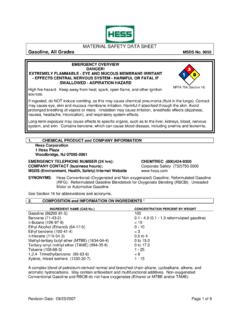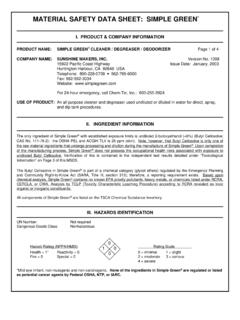Transcription of MATERIAL SAFETY DATA SHEET 76 Transformer Oil
1 MSDS Code: 775852 Page 1/8. Status: Final Date of Issue: 19-Jan-2004. _____. MATERIAL SAFETY DATA SHEET . 76 Transformer Oil 1. PRODUCT AND COMPANY IDENTIFICATION. Product Name: 76 Transformer Oil Product Code: 1041410. Intended Use: Insulating Oil Synonyms: Conoco Transformer Oil Phillips Transformer Oil Chemical Family: Petroleum Hydrocarbon Responsible Party: Conoco Lubricants A Division of ConocoPhillips 600 N. Dairy Ashford Houston, Texas 77079-1175. Customer Service: 800-255-9556. Technical Information: 800-255-9556. The intended use of this product is indicated above. If any additional use is known, please contact us at the Technical Information number listed. EMERGENCY OVERVIEW. 24 Hour Emergency Telephone Numbers: Spill, Leak, Fire or Accident Call CHEMTREC: North America: (800) 424-9300.
2 Others: (703) 527-3887 (collect). California Poison Control System: (800) 356-3219. Health Hazards/Precautionary Measures: Avoid contact with eyes, skin and clothing. Wash thoroughly after handling. Physical Hazards/Precautionary Measures: Keep away from all sources of ignition. Appearance: Clear brown Physical Form: Liquid Odor: Mild petroleum NFPA 704 Hazard Class: HMIS Hazard Class: Health: 1 (Slight) Health: 1 (Slight). Flammability: 1 (Slight) Flammability: 1 (Slight). Instability: 0 (Least) Physical Hazards: 0 (Least). MSDS Code: 775852 Page 2/8. Status: Final Date of Issue: 19-Jan-2004. _____. 2. COMPOSITION / INFORMATION ON INGREDIENTS. NON-HAZARDOUS COMPONENTS. Component / CAS No: Percent (%) ACGIH: OSHA: NIOSH: Other: Hydrotreated distillate , Light > 99 5 mg/m3 TWA 5 mg/m3 TWA 2500 mg/m3 IDLH as Oil Mist, if Naphthenic.
3 C15-30 10 mg/m3 STEL Generated 64742-53-6. 5 mg/m3 NOHSC. TWA. Additives <1 NE NE NE. PROPRIETARY. Note: State, local or other agencies or advisory groups may have established more stringent limits. Consult an industrial hygienist or similar professional, or your local agencies, for further information. 1%=10,000 PPM. NE=Not Established All components are listed on the TSCA inventory. 3. HAZARDS IDENTIFICATION. Potential Health Effects: Eye: Contact may cause mild eye irritation including stinging, watering, and redness. Skin: Contact may cause mild skin irritation including redness, and a burning sensation. Prolonged or repeated contact can worsen irritation by causing drying and cracking of the skin leading to dermatitis (inflammation). No harmful effects from skin absorption are expected.
4 Inhalation (Breathing): No information available. Studies by other exposure routes suggest a low degree of toxicity by inhalation. Ingestion (Swallowing): No harmful effects expected from ingestion. Signs and Symptoms: Effects of overexposure may include irritation of the nose and throat, irritation of the digestive tract, nausea and diarrhea. Cancer: Inadequate data available to evaluate the cancer hazard of this MATERIAL . Target Organs: Inadequate data available for this MATERIAL . Developmental: No data available for this MATERIAL . Pre-Existing Medical Conditions: Conditions aggravated by exposure may include skin disorders. 4. FIRST AID MEASURES. Eye: If irritation or redness develops, move victim away from exposure and into fresh air. Flush eyes with clean water. If symptoms persist, seek medical attention.
5 Skin: Wipe MATERIAL from skin and remove contaminated shoes and clothing. Cleanse affected area(s) thoroughly by washing with mild soap and water and, if necessary, a waterless skin cleanser. MSDS Code: 775852 Page 3/8. Status: Final Date of Issue: 19-Jan-2004. _____. Inhalation (Breathing): If respiratory symptoms develop, move victim away from source of exposure and into fresh air. If symptoms persist, seek medical attention. If victim is not breathing, clear airway and immediately begin artificial respiration. If breathing difficulties develop, oxygen should be administered by qualified personnel. Seek immediate medical attention. Ingestion (Swallowing): First aid is not normally required; however, if swallowed and symptoms develop, seek medical attention. Notes to Physician: High-pressure hydrocarbon injection injuries may produce substantial necrosis of underlying tissue despite an innocuous appearing external wound.
6 Often these injuries require extensive emergency surgical debridement and all injuries should be evaluated by a specialist in order to assess the extent of injury. Acute aspirations of large amounts of oil-laden MATERIAL may produce a serious aspiration pneumonia. Patients who aspirate these oils should be followed for the development of long-term sequelae. Inhalation exposure to oil mists below current workplace exposure limits is unlikely to cause pulmonary abnormalities. 5. FIRE-FIGHTING MEASURES. Flammable Properties: Flash Point: > 293 F / > 145 C. Test Method: (COC). OSHA Flammability Class: Not applicable LEL%: UEL%: Autoignition Temperature: No data Unusual Fire & Explosion Hazards: This MATERIAL may burn, but will not ignite readily. Vapors are heavier than air and can accumulate in low areas.
7 If container is not properly cooled, it can rupture in the heat of a fire. Extinguishing Media: Dry chemical, carbon dioxide, foam, or water spray is recommended. Water or foam may cause frothing of materials heated above 212 F. Carbon dioxide can displace oxygen. Use caution when applying carbon dioxide in confined spaces. Fire Fighting Instructions: For fires beyond the incipient stage, emergency responders in the immediate hazard area should wear bunker gear. When the potential chemical hazard is unknown, in enclosed or confined spaces, or when explicitly required by DOT, a self contained breathing apparatus should be worn. In addition, wear other appropriate protective equipment as conditions warrant (see Section 8). Isolate immediate hazard area, keep unauthorized personnel out. Stop spill/release if it can be done with minimal risk.
8 Move undamaged containers from immediate hazard area if it can be done with minimal risk. Water spray may be useful in minimizing or dispersing vapors and to protect personnel. Cool equipment exposed to fire with water, if it can be done with minimal risk. Avoid spreading burning liquid with water used for cooling purposes. 6. ACCIDENTAL RELEASE MEASURES. This MATERIAL may burn, but will not ignite readily. Keep all sources of ignition away from upwind and away from spill/release. Notify persons down wind of the spill/release, isolate immediate hazard area and keep unauthorized personnel out. Stop spill/release if it can be done with minimal risk. Wear appropriate protective equipment including respiratory protection as conditions warrant (see Section 8). MSDS Code: 775852 Page 4/8. Status: Final Date of Issue: 19-Jan-2004.
9 _____. Prevent spilled MATERIAL from entering sewers, storm drains, other unauthorized drainage systems, and natural waterways. Dike far ahead of spill for later recovery or disposal. Spilled MATERIAL may be absorbed into an appropriate absorbent MATERIAL . Notify fire authorities and appropriate federal, state, and local agencies. Immediate cleanup of any spill is recommended. If spill of any amount is made into or upon navigable waters, the contiguous zone, or adjoining shorelines, notify the National Response Center (phone number 800-424-8802). 7. HANDLING AND STORAGE. Handling: Do not enter confined spaces such as tanks or pits without following proper entry procedures such as ASTM. D-4276 and 29 CFR The use of appropriate respiratory protection is advised when concentrations exceed any established exposure limits (see Sections 2 and 8).
10 Do not wear contaminated clothing or shoes. Use good personal hygiene practices. High pressure injection of hydrocarbon fuels, hydraulic oils or greases under the skin may have serious consequences even though no symptoms or injury may be apparent. This can happen accidentally when using high pressure equipment such as high pressure grease guns, fuel injection apparatus or from pinhole leaks in tubing of high pressure hydraulic oil equipment. "Empty" containers retain residue and may be dangerous. Do not pressurize, cut, weld, braze, solder, drill, grind, or expose such containers to heat, flame, sparks, or other sources of ignition. They may explode and cause injury or death. "Empty" drums should be completely drained, properly bunged, and promptly shipped to the supplier or a drum reconditioner.




